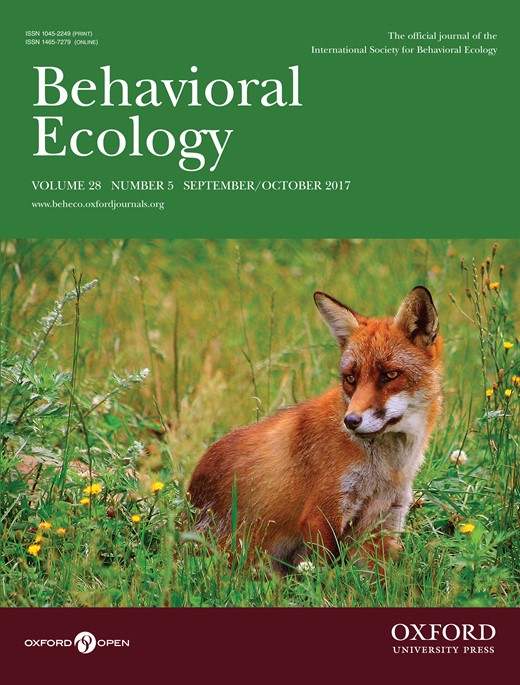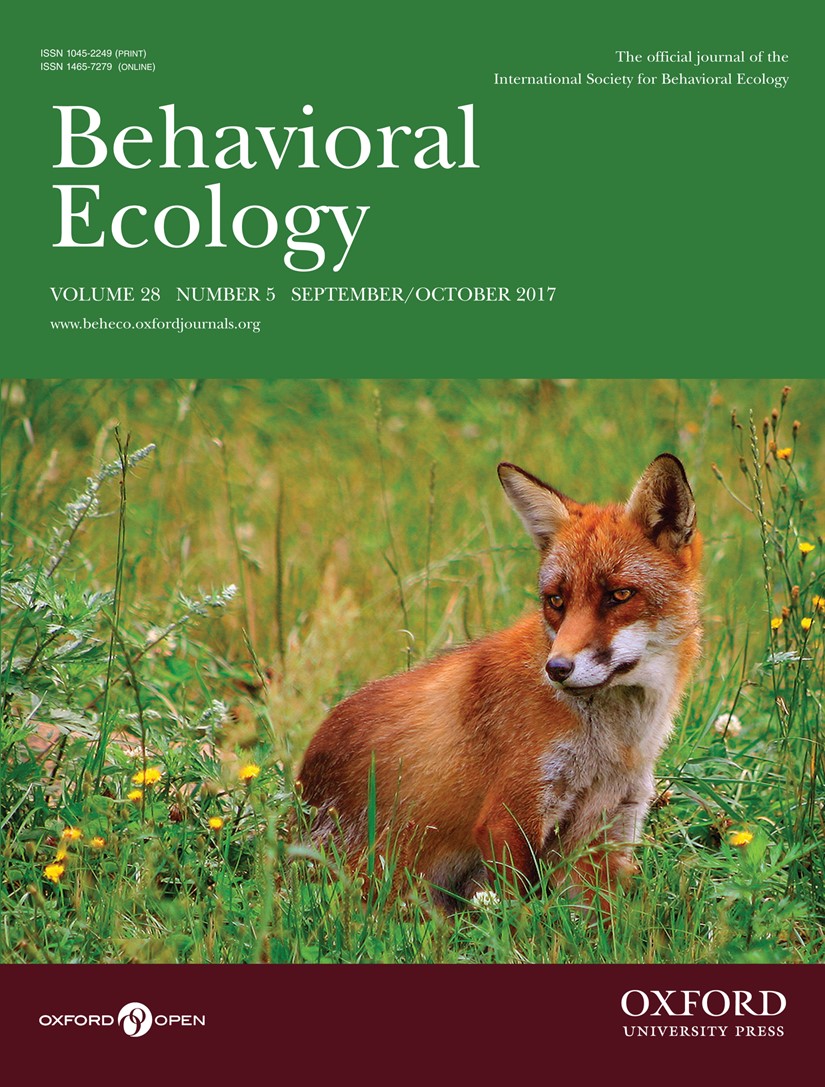
Cover image

Volume 28, Issue 5, September-October 2017
EDITORIAL
Obituary: Amotz Zahavi 1928–2017
EDITOR'S CHOICE
Male genital titillators and the intensity of post-copulatory sexual selection across bushcrickets
We examined the relationships between the complexity of male genital structures (titillators) and both the mating rate of males and females, and the number of times females mate, across a range of bushcricket species. We did not find any relationship between genital complexity and the number of times females mate. Among species with titillators, however, the complexity of these structures was associated with faster re-mating rates in females. The results therefore only partly support the hypothesis that the structure and complexity of genitalia relate to the intensity of sexual selection.
ORIGINAL ARTICLES
Food abundance, prey morphology, and diet specialization influence individual sea otter tool use
Whether sea otters use tools to dine depends on what’s for dinner. When calorie-rich food is plentiful, all otters eat the best foods and use tools only if hard-shelled prey like large clams are present. But when the menu includes less-desirable options including small, hard-shelled snails, only some otters eat snails and use tools to crack them. Similar factors may also drive tool use in other animals like crows or dolphins.
Do prevailing environmental factors influence human preferences for facial morphology?
This study shows that pathogens and urbanization play only a subtle role in human face preferences in a small-scale society.
Effects of individual-based preferences for colour-banded mates on sex allocation in zebra finches
Studies of colour-banded zebra finches have provided mixed support for the hypothesis that females paired with attractive males will produce more sons. Variation in female mate preferences could help to explain the conflicting patterns seen in previous studies. In our experiment, females varied in their preferences for males’ colour-bands. Females mated to males of their preference produced male-biased brood sex ratios at fledging, while the specific colour of male colour-bands did not affect offspring sex.
Seasonal variation in behavioral thermoregulation and predator avoidance in a small mammal
Behavior of pygmy rabbits varied seasonally to accommodate both thermal challenges and predation risk. We quantified selection of rest sites and activity during summer and winter to evaluate behavioral tradeoffs between thermal and security resources. Our work suggests that behavior might buffer individuals of this species against a changing climate, and it highlights the need for incorporating behavior into models of how individuals and populations of animals respond to climate change.
Camouflaging moving objects: crypsis and masquerade
We show that for objects moving in groups, spotting one that is a different shape is harder when the objects are similarly patterned. The difficulty of spotting the odd-one-out is further enhanced by matching the background and being in larger groups. So, even though motion ‘breaks’ camouflage, being camouflaged can help group-living animals reduce the risk of being singled out for attack by predators.
Duetting behavior varies with sex, season, and singing role in a tropical oriole (Icterus icterus)
Many birds sing with their mates, forming duets that could serve many functions. We found that duetting behavior varied between the 2 sexes and between the breeding and nonbreeding season. Both females and males answer their mate’s songs in both seasons to defend territories and maintain contact with each other. Males also answer their mate during the breeding season, possibly to guard their paternity. Thus duetting functions in both breeding and nonbreeding activities.
Early to rise, early to breed: a role for daily rhythms in seasonal reproduction
Do daily activity rhythms underlie observed variation in seasonal reproductive timing? Laboratory studies have found a link between daily activity rhythms and activation of the reproductive system. However, this relationship remains largely unexplored in the wild. We asked if females with early onset of activity would also breed earlier in the year. We found this to be true in 2 species of songbird, on 2 different continents, thus supporting our hypothesis.
Why does the rate of signal production in ectotherms vary with temperature?
Cold and hot lizards advertise territory ownership less than warm lizards because of thermal constraints on physiology. Social communication in cold-blooded animals is often linked to environmental temperature, but why has been unclear. We tested several hypotheses in a study of Caribbean anole lizards. The number of advertisement displays performed by lizards was dependent on temperature in a way that could only be explained by constraints on strenuous activity at cold and hot temperatures.
Marginal predation: do encounter or confusion effects explain the targeting of prey group edges?
Living in groups has been shown to have antipredator benefits for prey animals but risk still differs for individuals within a group. Using fish as predators presented with simulations of virtual prey, we show that prey on the edge of groups are more likely to be attacked than others, even at relatively small group sizes. We also show that encountering prey on the edge is likely to explain this effect rather than predatory confusion.
Wild dwarf mongooses produce general alert and predator-specific alarm calls
Dwarf mongooses, the smallest species in the mongoose family, produce a number of diverse alarm-call types, with several being general and 2 indicating predator type. Furthermore, the specificity of their alarm-call types appears higher for aerial than terrestrial threats and, unlike other mongoose species, they seem to use the same alarm-call type for both physically present terrestrial predators and secondary cues of their presence.
Dominance, gender, and season influence food patch use in a group-living, solitary foraging canid
Red foxes thrive in towns and cities, where much of their food is deliberately provided by humans. We studied fox foraging behavior using camera traps in residential gardens where householders regularly fed foxes. Predictable feeding patterns attracted foxes to gardens, females were more efficient foragers than males, and dominant foxes enjoyed priority access to food, so that subordinates had to adopt compensatory strategies. Understanding how foxes exploit resources may help address conflicts in urban areas.
Aquatic prey use countershading camouflage to match the visual background
Animals often have darker coloration on their top surface than on their underside (“countershading”). In terrestrial prey, this patterning eliminates the body’s shadows to facilitate camouflage. In a freshwater fish that can change color, countershading provides optimal camouflage for different visual backgrounds and viewing angles rather than to reduce shadowing. Countershading camouflage may operate differently in terrestrial and aquatic habitats.
Female anoles display less but attack more quickly than males in response to territorial intrusions
Female brown anole lizards, which are smaller and often thought of as less aggressive than males, attack same-sex intruders more quickly. In species where males are larger, the typical assumption is that males are more aggressive. We found that males are slower to attack and use more displays before escalating to a physical fight. This is consistent with the idea that fighting may be risky for males because of their stronger jaws.
Stomatopods detect and assess achromatic cues in contests
Stomatopods (mantis shrimp) may disclose their fighting ability to opponents when they display a colored patch, the meral spot. We used an ultrafast laser to increase meral spot brightness of a Caribbean stomatopod species. Fights over ownership of a refuge were shorter and more active when the resident stomatopod had a brightened meral spot. This suggests that stomatopods are more willing to engage in contests when their opponents have brighter meral spots.
A comparative analysis of the behavioral response to fishing boats in two albatross species
Smaller and less generalist Black-Browed albatrosses were more strongly attracted to encountered fishing boats than dominant Wandering albatrosses. Anthropogenic food sources enhance aggregations of large numbers of individuals and species, but are not necessarily exploited by all individuals encountering them, or not to the same extent. We hypothesize that these food sources may especially attract individuals with higher energetic demands and/or fewer alternative foraging options available.
Leopard distribution and abundance is unaffected by interference competition with lions
We tested the population-level effects of a dominant competitor—lions—on a subordinate—leopards. Although lions were a common cause of leopard mortality, they did not suppress or displace leopards. Population growth was similar between the 2 species and leopards did not avoid lions. Coexistence was likely possible because lions and leopards targeted different sized prey. Widespread poaching of large ungulates may increase levels of competition between lions and leopards by forcing them to target the same prey.
Mutual plumage ornamentation and biparental care: consequences for success in different environments
Parental care and reproductive success of collared flycatchers were related to own and partner’s sexual ornaments in partial interaction with environmental conditions. In a brood size manipulation experiment, male wing patch size and female plumage brightness correlated with the partner’s feeding rate. Nestling quality correlated with male forehead patch size depending on breeding environment. These findings reveal a complex picture of relationships between the sexual ornament expression of parents and their parental care and success.
Nest decoration as social signals by males and females: greenery and feathers in starling colonies
Male and female starlings decorate their nests more in crowded neighborhoods. The use of odd materials in bird nests, such as green plants or ornamental feathers, is often associated with the social status and competitive abilities of the owners. Here, we show that the density of conspecifics increases competition for breeding resources and stimulates the use of decorative materials by both sexes. Social environment in breeding colonies represents an evolutionary driver for intraspecific communication.
Prior information and social experience influence male reproductive decisions
Mate preferences vary among individuals. We show that male fruit fly courtship preferences are influenced by their previous experiences. Males that previously experienced a population of mostly large, high-quality females biased their subsequent courtship behavior toward large females more than males that had previously experienced mostly small females. Males that had experienced mostly small, low-quality females, and who had mated with a small female, tended to bias their subsequent courtship toward such low-quality females.
Crowding leads to fitness benefits and reduced dispersal in a colonial spider
Crowding is usually detrimental, but not necessarily for species that cluster in groups. In a colonial web-building spider, individuals had a lower tendency to disperse away from dense groups than from sparse groups. Spiders gained more weight on average in denser groups, although not all spiders within the colony benefited equally from the prey. The positive group effect was strongest when prey were abundant, suggesting that group-living is beneficial in prey-rich sites.


